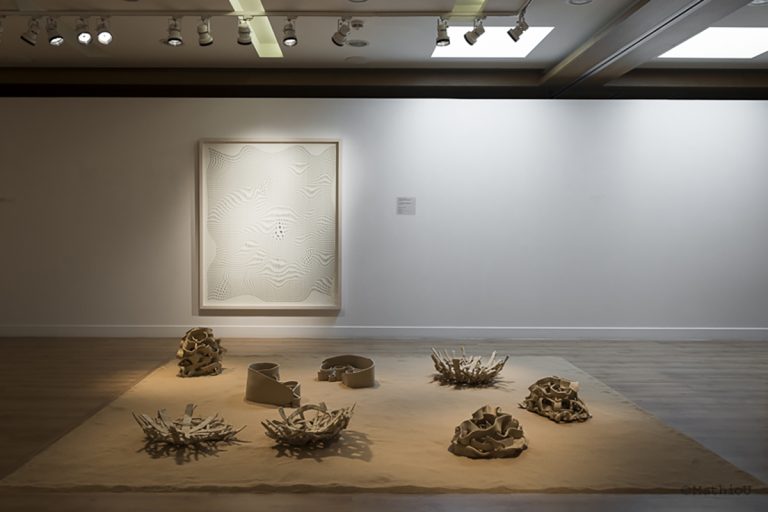Vicky Tsalamata’s work, particularly her project La Comédie Humaine C, offers a deep reflection on the human condition. Drawing from Honoré de Balzac’s La Comédie Humaine, this piece serves as a sarcastic commentary on how humans, past and present, find themselves subject to the overwhelming forces that shape their lives. Tsalamata highlights the insignificance of human worth within this larger scheme, while also stressing the essential need for connection in today’s world—especially after the isolation experienced during the global pandemic. Using mixed media and archival prints on Photo Rag Hahnemuehle 100% cotton art paper, Tsalamata conveys the delicate yet enduring aspects of human existence, emphasizing the subtle connections that bind us together and the invisible barriers that separate us.

In La Comédie Humaine C, Tsalamata delves into the theme of human interconnectedness. This piece is part of her larger project referencing Balzac’s famous work. It provides commentary on the human experience, suggesting that while we may feel insignificant in the grand scheme of things, our need for communication and connection is more critical than ever, especially after the isolation caused by the COVID-19 pandemic.

The visual space Tsalamata creates in this work is a “microcosm”—a symbolic representation rather than a realistic one. Her human forms are cut from 17 iron matrices, each shaped using an acetylene flame, and range from 21 to 29 centimeters in height. These figures are etched and detailed using techniques like aquatint, dry point, and open bite, giving them a rugged and raw appearance. Tsalamata’s approach emphasizes the imperfections and vulnerabilities of humanity, contrasting with more traditional, polished representations of the human form. Each figure reveals a sense of the complexity of human existence.
Tsalamata’s process is intricate and involves the use of high-resolution scanners to uncover details that are invisible to the naked eye. These small, unnoticed elements become essential to the overall texture and meaning of the piece. By scanning and manipulating the iron matrices, she creates intricate webs of human connections, stretching out infinitely. The result is a visual metaphor for the ties that link us together, whether we are aware of them or not.

These “webs of human unions” are central to the message of La Comédie Humaine C. Tsalamata explores the delicate balance between isolation and connection, particularly during times of crisis. Her iron matrices represent the interconnectedness of human life, drawing attention to the networks of relationships and dependencies that have become even more apparent in the digital age. Social media and online networks, in particular, play a significant role in shaping how we communicate and relate to one another today.
The inclusion of La Comédie Humaine C in the Sixth Cacak International Printmaking Biennial 2024 is a testament to how Tsalamata’s work resonates with the contemporary human experience. As the world recovers from the pandemic, her work speaks to the importance of reestablishing connections and finding meaning in our shared experiences.
Tsalamata further elaborates on her concept of “Synapsis” in her artist’s statement, exploring the idea of an “invisible order” that structures human relationships. She describes human history as a web, with social networks acting as a super-organism that functions beyond our individual understanding. These networks, composed of intricate shapes and patterns, influence our emotions, personal well-being, and the quality of our relationships.
She also touches on the impact of digital technology on modern human interactions. Social media and online platforms have transformed the way we communicate, creating new types of connections that were not previously possible. Tsalamata’s work captures the dynamic nature of these networks, questioning how they affect our personal relationships and our place within the larger social framework.
In La Comédie Humaine C, Tsalamata succeeds in capturing the essence of human interconnectedness and the complexity of our relationships with one another. Through her use of mixed media and advanced technology, she creates a layered narrative that invites viewers to reflect on their own experiences of connection and isolation. Her work offers a subtle critique of modern life while celebrating the enduring human need for communication and companionship.
The project demonstrates how traditional printmaking techniques can be combined with modern digital tools to produce meaningful and thought-provoking art. By printing the final work on archival fine art paper, Tsalamata ensures that her exploration of human connections will leave a lasting impression, much like the bonds that tie us together in the real world. Her project offers a contemplative view on how we exist within a vast network of relationships and how those relationships define our lives in ways we may not fully understand.

